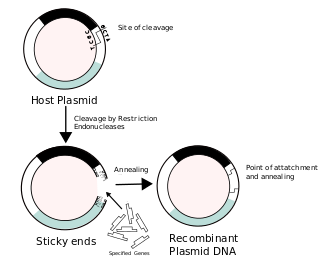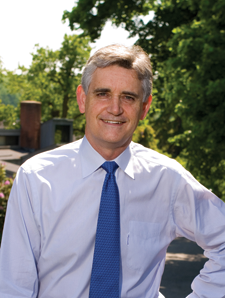
James Dewey Watson KBE is an American molecular biologist, geneticist and zoologist. In 1953, he co-authored with Francis Crick the academic paper proposing the double helix structure of the DNA molecule. Watson, Crick and Maurice Wilkins were awarded the 1962 Nobel Prize in Physiology or Medicine "for their discoveries concerning the molecular structure of nucleic acids and its significance for information transfer in living material".

Molecular biology is the branch of biology that concerns the molecular basis of biological activity in and between cells, including molecular synthesis, modification, mechanisms and interactions. The central dogma of molecular biology describes the process in which DNA is transcribed into RNA then translated into protein.

Max Ferdinand Perutz was an Austrian-born British molecular biologist, who shared the 1962 Nobel Prize for Chemistry with John Kendrew, for their studies of the structures of haemoglobin and myoglobin. He went on to win the Royal Medal of the Royal Society in 1971 and the Copley Medal in 1979. At Cambridge he founded and chaired (1962–79) The Medical Research Council (MRC) Laboratory of Molecular Biology (LMB), fourteen of whose scientists have won Nobel Prizes. Perutz's contributions to molecular biology in Cambridge are documented in The History of the University of Cambridge: Volume 4 published by the Cambridge University Press in 1992.

Max Ludwig Henning Delbrück, a German–American biophysicist, helped launch the molecular biology research program in the late 1930s. He stimulated physical scientists' interest into biology, especially as to basic research to physically explain genes, mysterious at the time. Formed in 1945 and led by Delbrück along with Salvador Luria and Alfred Hershey, the Phage Group made substantial headway unraveling important aspects of genetics. The three shared the 1969 Nobel Prize in Physiology or Medicine "for their discoveries concerning the replication mechanism and the genetic structure of viruses". He was the first physicist to predict what is now called Delbrück scattering.

Sydney Brenner was a South African biologist. In 2002, he shared the Nobel Prize in Physiology or Medicine with H. Robert Horvitz and Sir John E. Sulston. Brenner made significant contributions to work on the genetic code, and other areas of molecular biology while working in the Medical Research Council (MRC) Laboratory of Molecular Biology in Cambridge, England. He established the roundworm Caenorhabditis elegans as a model organism for the investigation of developmental biology, and founded the Molecular Sciences Institute in Berkeley, California, United States.

Cold Spring Harbor Laboratory (CSHL) is a private, non-profit institution with research programs focusing on cancer, neuroscience, plant biology, genomics, and quantitative biology.

Recombinant DNA (rDNA) molecules are DNA molecules formed by laboratory methods of genetic recombination to bring together genetic material from multiple sources, creating sequences that would not otherwise be found in the genome.
Joseph Frank Sambrook was a British molecular biologist known for his studies of DNA oncoviruses and the molecular biology of normal and cancerous cells.

Bruce Michael Alberts is an American biochemist and the Chancellor’s Leadership Chair in Biochemistry and Biophysics for Science and Education at the University of California, San Francisco. He has done important work studying the protein complexes which enable chromosome replication when living cells divide. He is known as an original author of the "canonical, influential, and best-selling scientific textbook" Molecular Biology of the Cell, and as Editor-in-Chief of Science magazine.
Garland Science was a publishing group that specialized in developing textbooks in a wide range of life sciences subjects, including cell and molecular biology, immunology, protein chemistry, genetics, and bioinformatics. It was a subsidiary of the Taylor & Francis Group.
The phage group was an informal network of biologists centered on Max Delbrück that contributed heavily to bacterial genetics and the origins of molecular biology in the mid-20th century. The phage group takes its name from bacteriophages, the bacteria-infecting viruses that the group used as experimental model organisms. In addition to Delbrück, important scientists associated with the phage group include: Salvador Luria, Alfred Hershey, Seymour Benzer, Gunther Stent, James D. Watson, Frank Stahl, and Renato Dulbecco.

Gunther S. Stent was Graduate Professor of Molecular Biology at the University of California, Berkeley. One of the early bacteriophage biologists, he was known also for his studies on the metabolism of bacteria and neurobiology of leeches, and for his writing on the history and philosophy of biology.

Stephen J. O'Brien is an American geneticist. He served as Chief of the Laboratory of Genomic Diversity at the National Cancer Institute (NCI), National Institutes of Health (NIH) from 1986 to 2011. In December 2011, he created the Theodosius Dobzhansky Center for Genome Bioinformatics, St. Petersburg State University, Russia as Chief Scientific Officer.

Keith Burridge is a British researcher and Kenan distinguished Professor at the University of North Carolina at Chapel Hill. His research on focal adhesions includes the discovery of many adhesion proteins including vinculin, talin and paxillin, and ranks him in top 1% of the most cited scientist in the field of molecular biology and genetics. Burridge has published more than 200 peer reviewed articles.

Klaus Weber was a German scientist who made many fundamentally important contributions to biochemistry, cell biology, and molecular biology, and was for many years the director of the Laboratory of Biochemistry and Cell Biology at the Max Planck Institute for Biophysical Chemistry in Göttingen, Germany.

Bruce William Stillman, AO, FAA, FRS is a biochemist and cancer researcher who has served as the Director of Cold Spring Harbor Laboratory (CSHL) since 1994 and President since 2003. He also served as the Director of its NCI-designated Cancer Center for 25 years from 1992 to 2016. During his leadership, CSHL has been ranked as the No. 1 institution in molecular biology and genetics research by Thomson Reuters. Stillman's research focuses on how chromosomes are duplicated in human cells and in yeast Saccharomyces cerevisiae; the mechanisms that ensure accurate inheritance of genetic material from one generation to the next; and how missteps in this process lead to cancer. For his accomplishments, Stillman has received numerous awards, including the Alfred P. Sloan, Jr. Prize in 2004 and the 2010 Louisa Gross Horwitz Prize, both of which he shared with Thomas J. Kelly of Memorial Sloan-Kettering Cancer Center, as well as the 2019 Canada Gairdner International Award for biomedical research, which he shared with John Diffley.
Jeffrey David Esko, Ph.D.,M.D. (h.c) is currently a Full Professor of Cellular and Molecular Medicine and Co-Director of the Glycobiology Research and Training Center at the University of California, San Diego. His research has focuses on understanding the structure, biosynthesis and biological roles of proteoglycans in mammalian cells and model organisms. Esko popularized proteoglycans through his pioneering genetic and functional studies in cells and model organisms. He discovered the dependence of tumor formation on heparan sulfate, the first small molecule inhibitors of heparan sulfate, the action of proteoglycans as receptors for hepatic lipoprotein clearance and for delivery of therapeutic agents. Esko cofounded Zacharon Pharmaceuticals. He was an editor and author of the first textbook in the Glycobiology field, Essentials of Glycobiology.
John Tooze FRS research scientist, research administrator, author, science journalist, formerly executive director of EMBO/EMBC, director of research services at the Cancer Research UK London Research Institute and a vice president at The Rockefeller University.
Gregory James Hannon is a professor of molecular cancer biology and director of the Cancer Research UK Cambridge Institute at the University of Cambridge. He is a Fellow of Trinity College, Cambridge while also serving as a director of cancer genomics at the New York Genome Center and an adjunct professor at Cold Spring Harbor Laboratory.
Miranda Robertson is a scientific editor. She is known for serving as Biology Editor at Nature from 1983 to 1992, during which time Nature's visibility and influence in the life sciences substantially increased, and for her contributions to the influential textbook Molecular Biology of the Cell. As editor of BMC's open-access Journal of Biology, she introduced pioneering improvements in the process of peer review, including the ability for authors to opt out of re-review.













